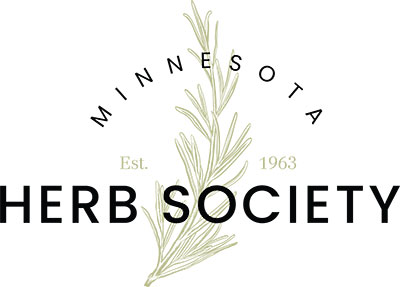Society’s interpretation of The Hmong Migration 2016
choosing our piece for this year’s interpretation, we were struck by the
refugee crisis in Syria and the Middle East. This piece highlights 12 of the 50
panels that Cy Thao painted, depicting his people’s migration to America. We chose 4 square vessels to represent the 4
rows of panels. We filled the vessels
with sand to show the dirt depicted in many of the panels. The upper far left panel shows the Creation
Story & the first vessel represents that tile. We used the herbs of Ferns, Rosemary, Basil, Hypericum,
Mums, and Capsicum (2016 International Herb Society Herb of the Year). We felt that the artwork was well represented
by the fiery hot presence of Capsicum (peppers), as it is a violent, emotional
piece of art. The middle two vessels we felt needed a thorny
presence, as the panels following the Creation panel are quite violent. We used Eryngium (purple thistle) as the main
base of these vessels. We also used the
delphinium to represent the blue river running thru the bottom panel and the yellow
ranuculus. Additionally we used
Eucalyptus to represent the tears of the Hmong and a few sprigs of Lavender,
along with a citronella Scented Geranium.
In the final vessel, we we have a
Sage plant for Wisdom with it’s roots exposed in the water to depict the
beginning of Hmong rooting in MN. We also incorporated the Hypericum, Rosemary
for Remembrance of their past, and the beautiful Delphinium to represent the
blue skies of the future. While the
journey of the Hmong is definitely not complete, it is important for all of us
to remember our ancestors who bravely entered a new country and faced
discrimination, violence, and finally, after a few generations, some
peace. Keep the continuing journey of
the Hmong, as well as all refugees in your heart.
members of the MN Herb Society, we use herbs in our arrangement. In particular, we choose to feature the International
Herb Society 2016 Herb of the Year, Capsicum. The following represent the herbs
we employed. Statements about the use of
these herbs are not intended to represent or imply suitability for treatment of
any conditions.
Society 2016 Herb of the Year. Capsicum,
more commonly known as pepper is not only an edible herb that is used
frequently in all sorts of dishes, but also used for medical purposes. Most commonly, capsicum in applied topically
to relieve arthritis and stiffness.
favorite, the chrysanthemum. The
Chrysanthemum has been used most predominantly in East Asia to prevent sore
throats & fevers. It is also known
for making people more alert, treat the eyes, & circulatory problems such
as varicose veins.
herb that is used in very small amounts. In the past, it was believed that this
herb could treat eye diseases. It was
used for intestinal worms, fluid retention, and can have a sedative
effect. It was also believed that
drinking the seeds of the plant wold help fight the effects of a scorpion
sting.
Ferns – The Cherokee people used
Maidenhair Fern for rheumatism. It can
also be used for fever, asthma. Some
Native American tribes used is for dysentery, snakebites, and as a
diuretic. The fiddleheads of ferns are
also edible and are similar in taste to asparagus, however, as always, check
the variety before ingesting.
Basil –
What can be said of Basil, except that it is the King of Herbs. It was
grown originally in Asia and the Middle East and it traveled along the Spice
trail. It has been grown and used for
5000 years. Basil is commonly used in
culinary dishes, but it also is an anti inflammatory. It helps with bowel inflammation and
rheumatoid arthritis. It’s properties
also can enhance circulation, and stabilize blood sugar. It is
also very high in antioxidants. Fresh
basil leaves and basil oil have antibacterial properties. The leaves can be applied to wounds and also
taken internally can help fight the common cold.
Rannuculus –
It is said that a tincture of ranunculus made with wine will help cure
shingles. It has also been used to treat
gout, and can help with certain types of headaches. It can cause inflammation and blistering of
skin. Pigs are fond of eating the roots
of ranunculus.
Sage – Held scared by Native
Americans. It’s effective purifying
energies is thought to bring back balance & cleanses the body & mind of
negative spririts. Native Americans used
it to create Kinnikinic, a smoking mixture to be used in sacred pipe as
offering to the Spirits. It was also
used in teas to flush ones system of impurities
with it’s cleansing properties.
Additional uses were as a natural deodorant, sore throat tonic,
antiseptic, healing of the scalp & hair, darkening of gray hair. Take a sprig of sage to your new home to
chase out old energies & to purify your home.
Antiseptic, Calming & stimulates the healing process. The fragrance of lavender is thought to
impart a feeling of inner freedom and many people use it to help relieve
stress. It also is a great herb to use
to heal cuts and scrapes.
dematological aid, hemostat, snake bite remedy, & general
strengthener. Modern uses include
treating mild depression.
and reminds us of the struggle of the refugees.
The roots are supposed to have some aphrodisiac virtues. According to a 17th century
apothecary, the roots are good for liver condition, easing cramps, and those
“withered with age”. Thistle seed can be
pressed to create an oil. In history,
thistle was also used as cattle fodder.
used with meats, in breads, teas, even desserts. For me personally, the scent is loveliest in
the midst of a grey winter day. In ancient times, Rosemary had a reputation for
strengthen the memory. Burning Rosemary
in sick chambers or hospitals was said to purify the air. The name rosemary derives from the Latin
for “dew” (ros) and “sea” (marinus), or
“dew of the sea”. Shakespeare
wrote “There’s rosemary, that’s for remembrance. Pray you, love, remember.”
to treat indigestion. In ancient times,
it was thought to clear the voice & cure hiccup. It is also used to treat gallstones &
colds.
a calming sensation. Also used for cleansing the face & as a deodorant
because of it’s antibacterial properties.
It was also said to reduce stomachaches & dried geranium leaves are used to repel insects in closets &
drawer.
Eucalyptus – Eucalyptus oils is an ingredient in
mouthwashes and dental prep. It also has
a strong antibacterial and antiflammatory properties. It is used in many cough products and is
vapor can act as a decongestant. The
U.S. registered Eucalyptus as an insecticide and it can be used to kill mites
and ticks.
Society encourages the study, the growing, & the use of herbs. We also plant & maintain the Herb Gardens
at the MN Landscape Arboretum.
Meetings are held the 4th Tuesday of January, March, May, August, &
October.


